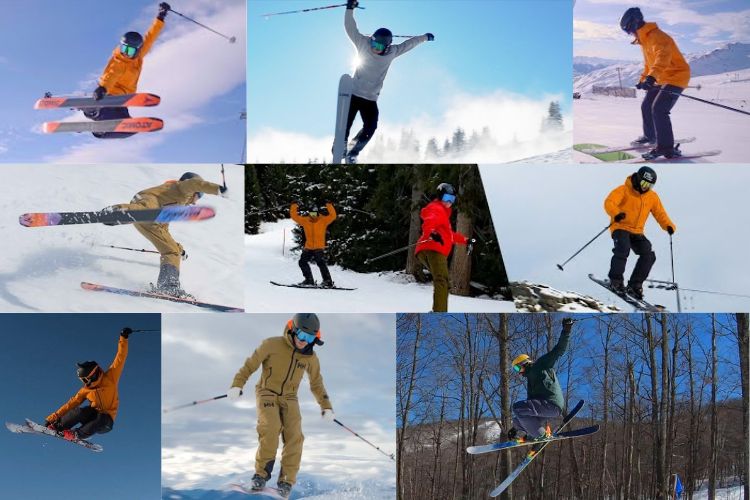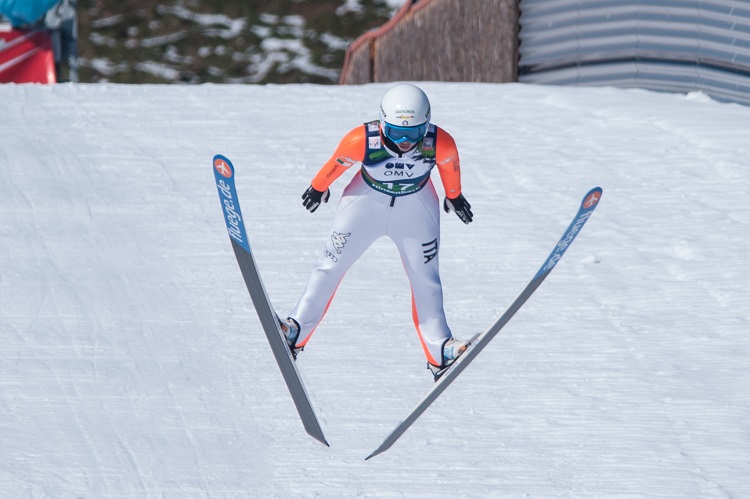Overview
Skiing in itself sounds daunting and challenging to many people. Now, what about ski jumping? I noped out so fast the first time I heard about it.
But, you know what? Jumping is a lot more fun than even racing. It not only gives you the best of the best adrenaline rushes and daredevil highs but is highly engaging for your mind.
A lot of judgment, timing, and critical decision-making is involved to ensure you generate momentum, maximize balance and perfect your landing. So here are the tips and tricks that helped me master the art!
Be a sport and try it out!
Jumping on Skis – Practice Makes Perfect

For landing the perfect ski jumps, there are 3 governing factors to keep in mind.
Speed, timing, and strategy!
Although the most important of all is keying in the right speed before taking off, your technique and timing also play an important role. By building up enough speed to get you to take off with strength and vigor, you ensure that you have accomplished a ski jump.
However, when you time your take off at the right time while angling your legs in the right way as well…that’s when you achieve the perfect winter Olympics kind of ski jump. So let’s get into how exactly you’re supposed to accomplish this kind of jumping technique.
- Start off in a standing position.
- Lean forwards slightly and angle your knees and hips forward in a manner that allows your back and legs to form a 45-degree angle.
- Center your body weight over the middle of your skis.
- At the lip of the jump, put in all your strength and straighten your back and legs as you leave the ground.
- As your skis touch the ground and you’re landing, you need to once more gradually bend your knees, in the same way, you did before, to avoid a major shock impact.
In the beginning, achieving the accurate form throughout all your ski jumps from start to finish is a bit challenging, but with practice, nothing is impossible.
Different Techniques Jump on Skis

As you must have guessed by now, ski jumping is different from normal jumping with a pair of ski boots on. Due to the straps and binding of the skis on your feet, your ankles and lower legs can’t freely move or play any role in strengthening or lengthening your jump.
Therefore, your entire performance is reliant on how you use your hips and knees to lean forward, create momentum and finally take off. But then again, how you use those two body parts also matters.
The Ollie Jumping Technique:
This technique involves the skier spreading their skis as far apart as they can to achieve larger jumps.
The Springing Technique:
This is similar to normal jumping, but the skier majorly utilizes their core strength and upper legs for the jump.
Although both techniques achieve the objective, which is a ski jump, there are different advantages and disadvantages to each technique.
The Techniques’ Objective
Here are some objectives of the mentioned techniques.
Timing

One of the most important aspects to heed, your timing makes a world of difference in your experience and outcome. The key to ensuring perfect timing and staying in the air longer is knowing when to stop pushing off from the ground.
While you’re at the lip of the jump, that is when you should stop propelling your body weight upwards and allow your prior effort to do its job.
This is sometimes the hardest part of ‘timing your effort’ (as I like to call it), as it is easier said than done. Myself included, it took me more than 7 months to accurately master the art of this.
For example, if you jump a tad bit too late, that will give you a pretty flat jump with less time in the air and more time on the ground dealing with the abrupt shock impact. On the other hand, if you jump too early, you won’t be able to get considerable height or distance.
Springing

Similar to how a literal spring works, springing is the process of assuming a crouched position and then pushing your body upwards to give yourself the momentum you need to be airborne. Here’s how you properly spring for your jump.
As you make your way to the take-off ramp, you need to keep your body in a crouched position. The moment your skis reach the lip of the jump, that’s when you start straightening your body and pushing yourself upwards.
As mentioned before, time this process in a way that your body is in full standing position as your skis are midway off the edge.
Finally, while in the air, tuck yourself into yourself. I’m serious! By tucking your body into itself, you not only keep your skis higher in the air, but it also looks extra cool.
Also, remember that in order to maintain good balance during this entire process, center your weight in the middle of your skis throughout.
The Ollie

The tricker of the two techniques, to Ollie, you need to focus on your timing more than your technique as that factor plays a major role. To execute this kind of jump on skis, you have to first lean forwards and then push yourself back so that the tips of your skis stick up in the air.
Now, this is where your timing is…critical!
As your ski tips are in the air, you’ll need to lean forward…again! But this time, you must prepare to launch your weight into a jump as soon as you reach the crucial point. The flex of the back of your skis plays an important role in helping you in springing upwards as well.
Since the Ollie strategy is all about keying in the right timing, it is generally better practiced at slower speeds and with the accurate calculation of when to propel your body weight upwards.
However, a miscalculation of timing could lead to an unwanted rotation in the air just as you take off, which would spoil your whole jump.
In the Air

Once you’re airborne, it can get pretty awkward! In the spur of the moment, you really have no idea what to do with your body. Don’t throw your arms out, no matter how reflexive that may feel!
You basically need to tuck your legs up into your torso and lean your hips forward. This helps decrease wind resistance and saves up your energy and movement when you land. As you are landing on the snow, that is when you kick out and assume the correct posture to land the jump flawlessly.
Also, the more airtime you have, the more important it is to not allow any rotations at take-off. Even a little rotation could spiral your balance out of control once you hit land.
Landing

This is the most essential part of the Ollie method. How you land determines how your body can absorb the impact of the jump.
In order to execute an exceptional landing, you need to extend your body from the tucked-in position you were in while in the air. However, remember to keep your knees and hips bent.
When touching down, let your skis touch the snow first, as that will help redirect them in the direction where you’re headed and absorb the sudden shock.
As soon as the full size of the skis is flat on the snow, lean forward, letting your knees touch your chest. This is important to not only absorb the impact and avoid falling but also center your weight in the middle of the skis.
Jumping Off of Kickers

Ever seen those skateboard parks with little take-off ramps? Kickers are similar to that but are found more in snow parks. They are built with a little ramp-like structure, followed by a little flat surface then the downward slopes start where you will land your jump.
If you’re using a kicker, you need to work on your springing technique, as that is the best way to get some good height on your jumps.
But if there’s anything I would advise y’all right from the start…is that you always need to lean yourself forward when using these kickers. If you don’t…well, you’ll end up on the snow on your back. Ouch!
Racing Technique

Racers never do jumps! Why? Well, because when you’re racing, you want to cover maximum distance in the least amount of time. Spending time in the air basically increases your total time taken. Not just that, but it also decreases their speed.
But then again, with the bumpy terrain of snow parks and slopes, one can’t help but get a wee bit of airtime. However, racers prevent the possibility of that happening by keeping their body compressed into themselves, and if a little bump does come in the way, then they time their jumps a bit early.
Recurrent Mistakes
We are all victims of some common mistakes while skiing. If we don’t pay attention to them, then your whole experience of the sport could be ruined. Here are some you should point-blank avoid:

- Spreading your arms out during a jump to try and balance yourself (also called windmilling)
- Misjudging your time of take-off
- Centering your weight on any part but the middle of your skis
- Wearing the wrong size boots
- Trying the Ollie technique on a kicker
Jump on Skis – Tips

- Don’t throw your arms out, but keep them tucked into your body while you’re in the air.
- Maintain your balance during take-off and time your jump accurately.
- Keep your body weight always centered in the middle of your skis by leaning forward.
- Ensure that your ski boots are a snug fit and do not cause any discomfort or pain during skiing.
- Try the Ollie strategy for smaller jumps in the beginning until you’re comfortable.
- For the springing technique, you should feel your shins press against the inside of your boots during take-off.
- Don’t go too fast when using a kicker.
Conclusion
The difference between skiing and ski jumping is the same as the difference between physics and math. Where both require some calculations, one is more about how the ski jumper practically applies those calculations in real life. The other is basically sticking to the formulas to get your answers.
Can you guess by now which is which?
All you ski jumpers, stay confident and have fun!
0 Comments